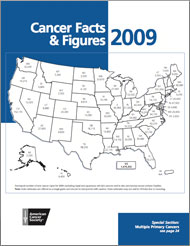Cancer Facts & Figures 2009

The 2009 edition of Cancer Facts & Figures provides the estimated numbers of new cancer cases and deaths in 2009 as well as cancer incidence, mortality, and survival statistics and information on cancer symptoms, risk factors, early detection, and treatment. About 1,479,350 new cancer cases were expected to be diagnosed in 2009, and in 2009 about 562,340 Americans were projected to die of cancer, more than 1,500 people a day. (Please note: The projected numbers of new cancer cases and deaths in 2009 should not be compared with previous years to track cancer trends because they are model-based and vary from year to year for reasons other than changes in cancer occurrence. Age-standardized incidence and death rates should be used to measure cancer trends.)
Cancer Facts & Figures 2009: Special Section
The topic of the special section of Cancer Facts & Figures 2009 is multiple primary cancers. Approximately 880,300 of the 11 million cancer survivors living in the US as of January 1, 2005, had been diagnosed with more than one cancer. Most of these second or more cancers would be expected to occur even if cancer survivors had the same risk of cancer as the general population. This Special Section provides background information about how clinicians and cancer registries define multiple primary cancers, statistics about the frequency and risk of subsequent cancers by primary site and the major risk factors of multiple cancers, and effects of treatment of a previous primary cancer, as well as detail on patterns of subsequent cancers for selected cancer sites (female breast cancer, colon and rectum, tobacco-related cancer, lymphomas, and melanoma) and childhood cancers.
Cancer Facts & Figures 2009 Supplemental Data
The Supplemental Data expands on the data provided in Cancer Facts & Figures by providing additional statistics by state and age group. This data can be used as a resource for cancer control planning, as well as to address questions from media or constituents about new cancer diagnoses and deaths. Divisions are encouraged to share this information with staff and volunteers, and to use it with state and local officials, the media, and other public health and advocacy groups in local communities.
- Cases and Deaths by Site, State 2009 (PDF)
- Cases and Deaths by Age 2009 (PDF)
- Observed and Relative 1-5 Year Survival 2009 (PDF)
- Lifetime Probability of Developing Cancer 2009 (PDF)
Most Requested Tables and Figures
The most requested tables and figures from Cancer Facts & Figures 2009 have been assembled in an electronic format (PDF) to make it easy for you to use them. Please note all graphic material should credit the American Cancer Society, Cancer Facts & Figures 2009.
- Age-Adjusted Cancer Death Rates, Males by Site, US, 1930-2005 (PDF)
- Age-Adjusted Cancer Death Rates, Females by Site, US, 1930-2005 (PDF)
- Estimated New Cancer Cases and Deaths by Sex, US, 2009 (PDF)
- Estimated New Cancer Cases for Selected Cancer Sites by State, US, 2009 (PDF)
- Estimated Cancer Deaths for Selected Cancer Sites by State, US, 2009 (PDF)
- Leading Sites of New Cancer Cases and Deaths—2009 Estimates (PDF)
- Probability of Developing Invasive Cancers Over Selected Age Intervals, by Sex, US, 2003-2005 (PDF)
- Cancer Incidence and Mortality Rates by Site, Race, and Ethnicity, US, 2001-2005 (PDF)
Cancer Statistics 2009 Slide Presentation
A presentation from the American Cancer Society reporting the estimated numbers of cancer cases and deaths in 2009 as well as current cancer incidence, mortality, and survival statistics and information on risk factors and early detection.



